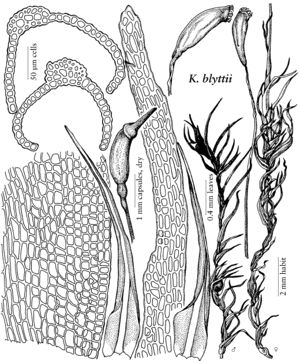Difference between revisions of "Kiaeria blyttii"
Laubm. Fennoskand., 87. 1923,.
FNA>Volume Importer |
FNA>Volume Importer |
||
| Line 13: | Line 13: | ||
|name=Arctoa blyttii | |name=Arctoa blyttii | ||
|authority=(Bruch & Schimper) Loeske | |authority=(Bruch & Schimper) Loeske | ||
| − | }}{{Treatment/ID/Synonym | + | }} {{Treatment/ID/Synonym |
|name=Arctoa blyttii var. hispidula | |name=Arctoa blyttii var. hispidula | ||
|authority=(R. S. Williams) Grout | |authority=(R. S. Williams) Grout | ||
| Line 30: | Line 30: | ||
|elevation=alpine elevations | |elevation=alpine elevations | ||
|distribution=Alta.;B.C.;Nfld. and Labr. (Nfld.);N.W.T.;N.S.;Ont.;Que.;Yukon;Alaska;Calif.;Idaho;Maine;N.H.;N.Y.;Oreg.;Wash.;Europe;Asia. | |distribution=Alta.;B.C.;Nfld. and Labr. (Nfld.);N.W.T.;N.S.;Ont.;Que.;Yukon;Alaska;Calif.;Idaho;Maine;N.H.;N.Y.;Oreg.;Wash.;Europe;Asia. | ||
| − | |discussion=<p>Kiaeria blyttii is distinguished by position of the male inflorescence at the ends of separate branches or well below the perichaetia, giving the appearance of separate stems (polyoicous). In the field, it can be distinguished from small sterile forms of K. starkei by its more terrestrial habit, spreading leaves, dull, dark green or brownish color, and lack of grooves on the dry capsules.</p> | + | |discussion=<p><i>Kiaeria blyttii</i> is distinguished by position of the male inflorescence at the ends of separate branches or well below the perichaetia, giving the appearance of separate stems (polyoicous). In the field, it can be distinguished from small sterile forms of <i>K. starkei</i> by its more terrestrial habit, spreading leaves, dull, dark green or brownish color, and lack of grooves on the dry capsules.</p> |
|tables= | |tables= | ||
|references= | |references= | ||
| Line 53: | Line 53: | ||
|publication year= | |publication year= | ||
|special status= | |special status= | ||
| − | |source xml=https://jpend@bitbucket.org/aafc-mbb/fna-data-curation.git/src/ | + | |source xml=https://jpend@bitbucket.org/aafc-mbb/fna-data-curation.git/src/8f726806613d60c220dc4493de13607dd3150896/coarse_grained_fna_xml/V27/V27_599.xml |
|genus=Kiaeria | |genus=Kiaeria | ||
|species=Kiaeria blyttii | |species=Kiaeria blyttii | ||
Revision as of 17:56, 18 September 2019
Plants in loose or brown tufts, dark green, dull. Stems 1–2 cm. Branch leaves erect-spreading, flexuose and somewhat crisped when dry, lanceolate, gradually subulate, 2–4 mm, margins occasionally distally 2-stratose; costa 35–50 µm at base; distal laminal cells mostly subquadrate (1–2:1), 8–11 µm wide, papillose on the dorsal surface; basal laminal cells elongate, smooth, sometimes porose, alar cells gradually enlarged. Perichaetial leaves similar to the cauline. Perigonia terminal on separate branches or located well below the perichaetia. Capsule not ribbed when dry, urn 1–1.2 mm. Spores 13–23 µm.
Habitat: Soil in rock crevices or acid rock
Elevation: alpine elevations
Distribution
Alta., B.C., Nfld. and Labr. (Nfld.), N.W.T., N.S., Ont., Que., Yukon, Alaska, Calif., Idaho, Maine, N.H., N.Y., Oreg., Wash., Europe, Asia.
Discussion
Kiaeria blyttii is distinguished by position of the male inflorescence at the ends of separate branches or well below the perichaetia, giving the appearance of separate stems (polyoicous). In the field, it can be distinguished from small sterile forms of K. starkei by its more terrestrial habit, spreading leaves, dull, dark green or brownish color, and lack of grooves on the dry capsules.
Selected References
None.
